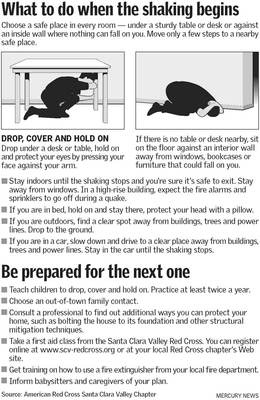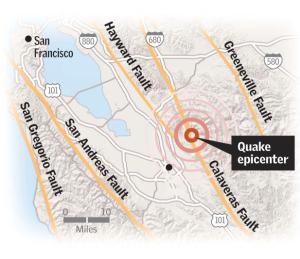
|
| ©American Red Cross |
| Instructional earthquake preparedness leaflet from American Red Cross |
Cell phone providers acknowledged brief disruptions in service, but say their systems aren't designed to accommodate the dramatic increases in call volume that occurred in the minutes after Tuesday's 8:04 p.m. Alum Rock quake.
In a bigger disaster, cell phone companies say, people shouldn't count on being able to use their cell phones immediately.
Yet regulatory advocates question if enough attention is being paid to whether the companies are putting enough resources into the network capacity needed when a disaster strikes.
For some, the solution was simple: text messaging.
For others, like 33-year-old Yvette Ostil of San Jose, the refrain was the same for what phone companies said was 30 minutes to an hour after the earthquake: "We kept trying to call my family and all the lines were busy."
The dilemma isn't a new one. During the Minnesota bridge collapse earlier this year, some people on the scene said they couldn't get a connection - even though cell phone carriers said they tried to move quickly to meet the increased demand.
But Regina Costa, telecommunications research director for The Utility Reform Network (TURN) in San Francisco, said little regulatory attention has been paid to how the phone companies are handling network capacity.
An AT&T spokesman acknowledged that the trouble extended to both the company's wired and wireless networks, but the disruption among wireless carriers highlighted the extra risks faced by the growing number of people who rely solely on cell phones.
Verizon Wireless said customers placed 2.3 million calls in Santa Clara County from 8 to 9 p.m. Tuesday, up from a typical average of 300,000 during that hour. There were no power or network failures, but the torrent of activity meant numerous calls failed as "ineffective attempts" because of the congestion.
Sprint Nextel declined to give specific numbers but said its wireless call volume increased tenfold in the San Jose area from 8 to 9 p.m., with the number of blocked calls rising about sevenfold.
To keep phone systems working for people in emergency situations, disaster-preparedness organizations and the wireless carriers urge customers to avoid making unnecessary calls.

|
| ©Mercury News |
"We have to remind ourselves that we may be making matters worse by trying to place a call for a non-urgent matter than to just take a deep breath and let it go for a bit and let the priority communication go first," said Bruce Lee, interim director of the Santa Clara County Office of Emergency Services.
But that may not seem practical to most who believe they would need to make the call to friends or relatives just to determine if there's a problem.
Tuesday night, despite generally little damage and no reports of major injuries, people immediately resorted in droves to their phones.
"There may be a better answer, which is to use text messaging," said Dennis McSweeney, area vice president for Sprint Nextel.
McSweeney and other phone officials said text messages, which can be sent to groups of recipients, take up a much smaller amount of a network's resources, freeing up transmission capacity for urgent calls.
Still, the phone companies, which emphasized the brief nature of Tuesday's problems, insisted that it's neither pragmatic nor economically sensible to build networks that would have enough capacity to cope with rare and extreme events.
Roger Entner, senior vice president-communications sector for IAG Research, said building such a network would be like building a second bridge next to a first one, just in case one or the other collapses.
"You cannot anticipate when and where you have that kind of catastrophic failure, and it would become too expensive for people to afford it," Entner said. He also noted that it's easier to build redundant capacity for landline systems because the location of calls is far more predictable.
But TURN's Costa believes the state's Public Utilities Commission has "abdicated its duty" by leaving the quality of service up to the phone companies.
"The PUC is not paying nearly enough attention to the adequacy of these systems," said Costa, who also said Silicon Valley has a history of being under-networked by Pacific Bell, which is now part of AT&T.
The PUC responded by sending an e-mail, which read in part: "The FCC (Federal Communications Commission) governs rates, the PUC handles 'terms and conditions' of service. The wireless market is very competitive so lower levels of regulation have been deemed appropriate, but the PUC cares about consumers and handles any consumer complaints or fraud issues."
The wireless carriers said they plan for jumps in traffic by tracking their busiest hours and then calculating how much additional capacity they're likely to need at times.
But Jack Tang, executive director of network for Verizon Wireless, said there are a number of challenges to keeping pace with growth in cell phone use, sometimes including community resistance to the placement of transmission towers.



Comment: The above article references the following earthquake in California on 30 October 2007:
Moderate earthquake of 5.6 rattles Bay Area